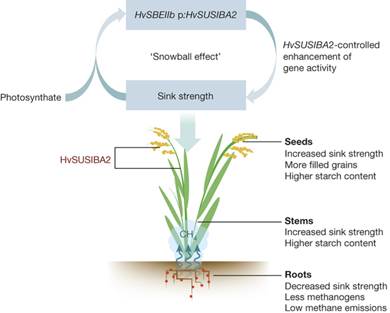第一种高淀粉产量、低甲烷排放的水稻问世
来源:《Nature》
作者:J. Su等
时间:2015-07-31


科学家们最近开发了一种新型转基因(GM)水稻,能显著减少农业对气候的影响。这种水稻装备了大麦的DNA,不仅产量更高,而且甲烷(一种很强的温室气体)释放量只是传统水稻的1%。这种水稻有助于提高粮食生产的可持续性,因此备受关注。
全球变暖有20%是甲烷引起的,而主要的人类甲烷排放来自农业活动,包括使用粪肥和种植水稻。为什么水稻会有这样的影响呢?水稻大多生长在缺氧的淹水土壤中,那里是产甲烷细菌的天堂。80% 到90%的稻田甲烷排放来自于水稻根部的细菌,这些细菌生产的甲烷大部分和水一起被植物根系吸收,通过茎和叶片逃逸到大气中。
2002年科学家们发现,谷粒越多的水稻释放的甲烷越少。因为,谷粒以淀粉形式锁住了更多的碳,让土壤中的细菌无法使用。水稻等植物一般会通过根部释放含碳量丰富的糖类和其他化合物,为土壤生态系统作贡献,滋养各种各样的细菌。此外,细菌也可以利用根部腐烂时释放的碳。
瑞典农业大学的孙传信(C. Sun)、福建省农科院的王锋(F. Wang)领导研究团队,开发了一种带有大麦DNA的新型水稻,这一成果于七月二十二日发表在Nature杂志上。研究人员将编码转录因子的一个大麦基因插入水稻中,使水稻种子的淀粉含量提高到干重的86.9%,而传统水稻的淀粉含量只有76.7%。
研究人员发现,转基因水稻根部的产甲烷细菌比传统水稻少得多。温室和试验田研究证实,转基因水稻释放的甲烷只有传统品种的0.3% 到10%,而且气温较高的时候甲烷减少更为显著。这种转基因水稻在全球变暖的今天是非常有价值的,孙教授说。
这种新型水稻还有助于解决随着人口增加而日益严重的粮食问题。因为这种水稻的产量得到了很大的提升,从16g每株涨到了24g每株。
当然,转基因作物如今面临着不少阻力。“中国社会目前对转基因作物非常敏感,”孙教授说。在水稻中寻找类似的转录因子,也许可以解决这方面的问题。同时研究人员也在探索如何进行更大规模的田间试验。(来源:生物通编辑 叶予)
Expression of barley SUSIBA2 transcription factor yields high-starch low-methane rice
Abstract Atmospheric methane is the second most important greenhouse gas after carbon dioxide, and is responsible for about 20% of the global warming effect since pre-industrial times. Rice paddies are the largest anthropogenic methane source and produce 7–17% of atmospheric methane. Warm waterlogged soil and exuded nutrients from rice roots provide ideal conditions for methanogenesis in paddies with annual methane emissions of 25–100-million tonnes. This scenario will be exacerbated by an expansion in rice cultivation needed to meet the escalating demand for food in the coming decades. There is an urgent need to establish sustainable technologies for increasing rice production while reducing methane fluxes from rice paddies. However, ongoing efforts for methane mitigation in rice paddies are mainly based on farming practices and measures that are difficult to implement. Despite proposed strategies to increase rice productivity and reduce methane emissions, no high-starch low-methane-emission rice has been developed. Here we show that the addition of a single transcription factor gene, barley SUSIBA2, conferred a shift of carbon flux to SUSIBA2 rice, favouring the allocation of photosynthates to aboveground biomass over allocation to roots. The altered allocation resulted in an increased biomass and starch content in the seeds and stems, and suppressed methanogenesis, possibly through a reduction in root exudates. Three-year field trials in China demonstrated that the cultivation of SUSIBA2 rice was associated with a significant reduction in methane emissions and a decrease in rhizospheric methanogen levels. SUSIBA2 rice offers a sustainable means of providing increased starch content for food production while reducing greenhouse gas emissions from rice cultivation. Approaches to increase rice productivity and reduce methane emissions as seen in SUSIBA2 rice may be particularly beneficial in a future climate with rising temperatures resulting in increased methane emissions from paddies.
原文链接:http://www.nature.com/nature/journal/vaop/ncurrent/pdf/nature14673.pdf




